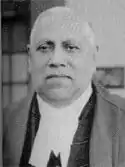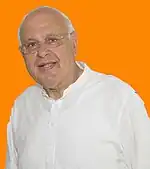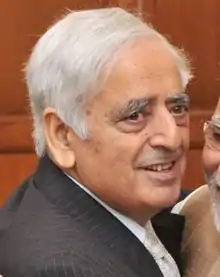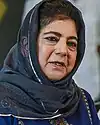| Chief Minister of Union Territory/State of Jammu and Kashmir and prime minsters | |
|---|---|
 | |
Incumbent vacant since 31 October 2019 | |
| Status | Head of Government |
| Abbreviation | CM |
| Member of | Jammu and Kashmir Legislative Assembly |
| Reports to | Lt. Governor of Jammu and Kashmir |
| Appointer | Lt. Governor of Jammu and Kashmir |
| Inaugural holder | Sheikh abdullah (as prime minister) |
| Formation | 30 March 1965 |
The chief minister of Jammu and Kashmir was the title given to the head of government of Jammu and Kashmir. As per the Constitution of India, the lieutenant governor is the state's de jure head, but de facto executive authority rests with the chief minister. Following elections to the Jammu and Kashmir Legislative Assembly, the lieutenant governor usually invites the party (or coalition) with a majority of seats to form the government. The lieutenant governor appoints the chief minister, whose council of ministers are collectively responsible to the assembly.
The post was established after the 6th amendment to the state's constitution (effective 6 June 1965) abolished the title of Prime Minister of Jammu and Kashmir.[1][2][3] Subsequently, the ruling prime minister, Ghulam Mohammed Sadiq, was sworn in as the first chief minister of Jammu and Kashmir. The State of Jammu and Kashmir was reorganised into a union territory on 31 October 2019.
The office of Chief Minister of Jammu and Kashmir has been vacant since 20 June 2018. Until 19 December 2018 the state was under the governor's rule, and then under the president's rule until 30 October 2019. After the state was reorganised into a Union territory in October 2019, the president's rule was discharged via the lieutenant governor. Currently, the Lieutenant Governor of Jammu and Kashmir serves as the head of government of union territory of Jammu and Kashmir until a new chief minister is in place following the next Jammu and Kashmir Legislative Assembly election.
Prime ministers of state of Jammu and Kashmir (1947–1965)
Colour key for parties
| Prime Ministers of Jammu and Kashmir | ||||||||||
|---|---|---|---|---|---|---|---|---|---|---|
| No.[lower-alpha 1] | Portrait | Name | Constituency | Tenure[4] | Assembly | Appointer
(Sadr-e-Riyasat) |
Party[lower-alpha 2] | |||
| From | To | Days in office | ||||||||
| 1 |  |
Mehr Chand Mahajan | – | 15 October 1947 | 5 March 1948 | 142 days | Interim
Government |
Maharaja Hari Singh
(Monarch) |
Independent | |
| 2 |  |
Sheikh Abdullah | – | 5 March 1948 | 31 October 1951 | 5 years, 157 days | National Conference | |||
| 31 October 1951 | 9 August 1953 | 1st Assembly | ||||||||
| 3 | Bakshi Ghulam Mohammad | Safa Kadal | 9 August 1953 | 25 March 1957 | 10 years, 125 days | Maharaja Karan Singh | ||||
| 25 March 1957 | 18 February 1962 | 2nd Assembly | ||||||||
| 18 February 1962 | 12 October 1963 | 3rd Assembly | ||||||||
| 4 | Khwaja Shamsuddin | Anantnag | 12 October 1963 | 29 February 1964 | 140 days | |||||
| 5 |  |
Ghulam Mohammed Sadiq | Tankipura | 29 February 1964 | 30 March 1965 | 1 year, 30 days | Indian National Congress | |||
Chief ministers of the state of Jammu and Kashmir (1965–2019)
Colour key for parties
| No[lower-alpha 3] | Portrait | Name | Constituency | Tenure[4] | Assembly | Party[lower-alpha 4] | |||
|---|---|---|---|---|---|---|---|---|---|
| 1 |  |
Ghulam Mohammed Sadiq | Tankipura | 30 March 1965 | 21 February 1967 | 6 years, 257 days | 3rd | Indian National Congress | |
| Amira Kadal | 21 February 1967 | 12 December 1971 | 4th | ||||||
| 2 | Syed Mir Qasim | Verinag | 12 December 1971 | 17 June 1972 | 3 years, 75 days | ||||
| 17 June 1972 | 25 February 1975 | 5th | |||||||
| 3 |  |
Sheikh Abdullah | MLC | 25 February 1975 | 26 March 1977 | 2 years, 29 days | National Conference | ||
| – |  |
Vacant (Governor's rule) |
N/A | 26 March 1977 | 9 July 1977 | 105 days | Dissolved | N/A | |
| (3) |  |
Sheikh Abdullah | Ganderbal | 9 July 1977 | 8 September 1982 | 5 years, 61 days | 6th | National Conference | |
| 4 |  |
Farooq Abdullah | Ganderbal | 8 September 1982 | 24 November 1983 | 1 year, 298 days | |||
| 24 November 1983 | 2 July 1984 | 7th | |||||||
| 5 | Ghulam Mohammad Shah | MLC | 2 July 1984 | 6 March 1986 | 1 year, 247 days | Awami National Conference | |||
| – |  |
Vacant (Governor's rule) |
N/A | 6 March 1986 | 5 September 1986 | 183 days | N/A | ||
| – |  |
Vacant (President's rule) |
N/A | 6 September 1986 | 7 November 1986 | 62 days | |||
| (4) |  |
Farooq Abdullah | Ganderbal | 7 November 1986 | 23 March 1987 | 3 years, 73 days | National Conference | ||
| 23 March 1987 | 19 January 1990 | 8th | |||||||
| – |  |
Vacant (Governor's rule) |
N/A | 19 January 1990 | 18 July 1990 | 180 days | Dissolved | N/A | |
| – |  |
Vacant (President's rule) |
N/A | 19 July 1990 | 9 October 1996 | 6 years, 82 days | |||
| (4) |  |
Farooq Abdullah | Ganderbal | 9 October 1996 | 18 October 2002 | 6 years, 9 days | 9th (1996 election) |
National Conference | |
| - |  |
Vacant (Governor's rule) |
N/A | 18 October 2002 | 2 November 2002 | 15 days | 10th (2002 election) |
N/A | |
| 6 |  |
Mufti Mohammad Sayeed | Pahalgam | 2 November 2002 | 2 November 2005 | 3 years, 0 days | People's Democratic Party | ||
| 7 |  |
Ghulam Nabi Azad | Bhaderwah | 2 November 2005 | 11 July 2008 | 2 years, 252 days | Indian National Congress | ||
| – |  |
Vacant (Governor's rule) |
N/A | 11 July 2008 | 5 January 2009 | 178 days | Dissolved | N/A | |
| 8 | .jpg.webp) |
Omar Abdullah | Ganderbal | 5 January 2009 | 8 January 2015 | 6 years, 3 days | 11th (2008 election) |
National Conference | |
| – |  |
Vacant[5] (Governor's rule) |
N/A | 8 January 2015 | 1 March 2015 | 52 days | 12th (2014 election) |
N/A | |
| (6) |  |
Mufti Mohammad Sayeed | Anantnag | 1 March 2015 | 7 January 2016 | 312 days | People's Democratic Party | ||
| – |  |
Vacant (Governor's rule) |
N/A | 7 January 2016 | 4 April 2016 | 88 days | N/A | ||
| 9 |  |
Mehbooba Mufti | Anantnag | 4 April 2016 | 20 June 2018 | 2 years, 77 days | People's Democratic Party | ||
| – |  |
Vacant[6] (Governor's rule) |
N/A | 20 June 2018 | 19 December 2018 | 182 days | Dissolved | N/A | |
| – |  |
Vacant[7] (President's rule) |
N/A | 20 December 2018 | 30 October 2019 | 314 days | |||
See also
Notes
- ↑ A parenthetical number indicates that the incumbent has previously held office.
- ↑ This column only names the chief minister's party. The state government he headed may have been a complex coalition of several parties and independents; these are not listed here.
- ↑ A parenthetical number indicates that the incumbent has previously held office.
- ↑ This columnister's party. The state government he headed may have been a complex coalition of several parties and independents; these are not listed here.
References
- ↑ "A J&K Primer: From Myth to Reality | Centre for Policy Research". www.cprindia.org. Retrieved 12 May 2020.
- ↑ "From 1965 to 2009, Om Prakash is the eighth chief minister". Hindustan Times. 5 January 2009. Archived from the original on 29 June 2011.
- ↑ "Chronicle of Important events/date in J&K's political history". www.jammu-kashmir.com. Retrieved 12 May 2020.
- 1 2 Prime Ministers and Chief Ministers of Jammu and Kashmir since 1947. General Administration Department, Government of Jammu and Kashmir. Retrieved on 29 April 2014.
- ↑ Bharti Jain. "Governor's rule imposed in Jammu & Kashmir". The Times of India. 9 January 2015.
- ↑ "President approves governor's rule in Jammu and Kashmir". The Times of India. 20 June 2018.
- ↑ "President’s Rule Imposed in Jammu and Kashmir". The Quint. 19 December 2018.